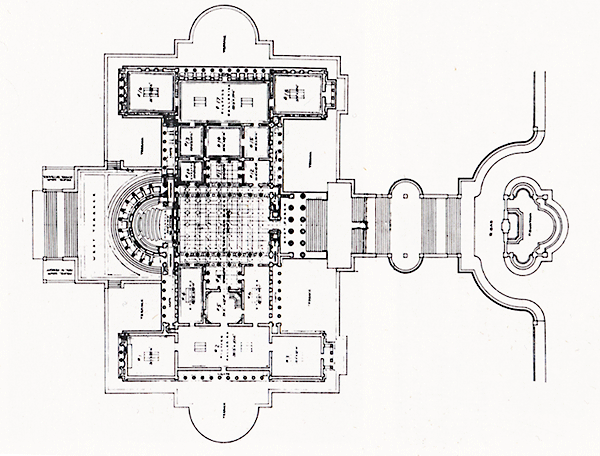
E.B.Green Design for the Albright Art Gallery, April 1900. Image source: "100: The Buffalo Fine Arts Academy"
Located on Buffalo parkland, the art gallery named for its benefactor, John J. Albright, opened in 1905. Designed by Buffalo architect, E.B. Green, it was intended to pay homage to a Greek temple, the Erectheum, and to the Greek Revival Style which emphasized balance. The western entrance stairs, which rise from Lincoln Parkway, were echoed in the stairs on the Elmwood side.


Pull the arrow tab left or right to view a comparison of the 1913 and 2015 views as seen from Elmwood Avenue.
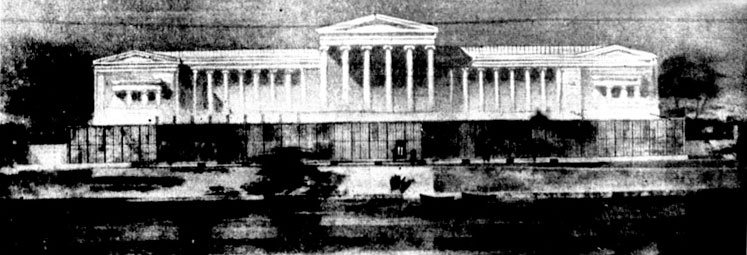
Architect's 1957 drawing of an addition to the Lincoln Parkway side. Image source: Buffalo Evening News
The Courier-Express announced on Valentine's Day, 1956, that the Albright Art Gallery "will be renovated as quickly as plans can be drawn up." The priorities were: a new auditorium seating 350, a gallery to hold at least 75 more paintings, a new outdoor sculpture court, and a new members' room with "a picture window looking out on Delaware Lake." The gallery director, Gordon Smith, said, "There will be no change to the exterior of the building."
Paul Schweikher, Director of the Yale School of Architecture, drew the plan above, which replaced the grand entrance stairs on the Lincoln Parkway side of the gallery with a low, glass rectangular building sited lower than the first floor of the gallery and intended to visually form a base for the gallery. It would be 258 feet wide and 86 feet deep, containing new stairs leading up to the central court. In addition to suggesting that public funding would be very helpful for the project, the gallery's board said that the "project's success also depends on obtaining sorely needed parking space on adjoining city land." One proposal called for a 125-car lot on the site of the Delaware Greenhouse which was park property. On October 3, 1957, news came that the city Parks Department would design a 144 car lot between the gallery and Elmwood Avenue.
Public outcry over Schweikher's design was immediate. Sculptor Larry Griffis penned a two-column opinion in the Buffalo Evening News on October 23, 1957, entitled, "Albright Needs a New Building Without Defacing the Old." He suggested that a new building be constructed separately from the 1905 building that would be entirely devoted to contemporary art. And he suggested that the Delaware Greenhouse would be a perfect location. Other gallery members expressed outrage and dismay that the gallery would be so harshly altered. This design was abandoned.
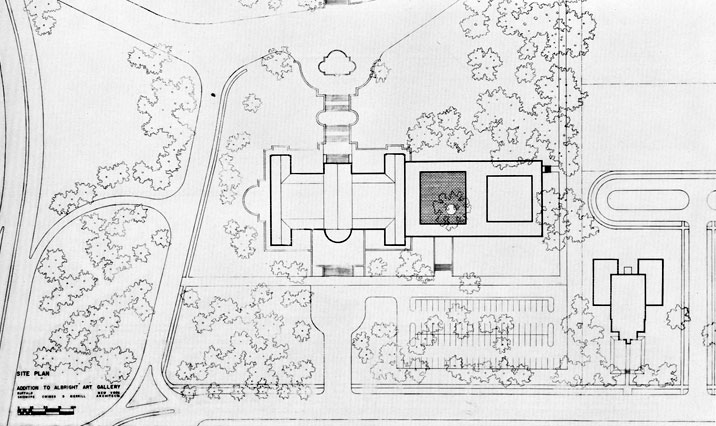
May 1958 Bunshaft plan. Image source: "100: The Buffalo Fine Arts Academy"
And then, in early 1958, Buffalo native and architect Gordon Bunshaft (Skidmore, Owings, Merrill) was hired to create a new design. This design sited an addition south of the gallery on park land that included the Delaware Greenhouse. It also retained the original Elmwood entrance and located the parking lot directly in front of a new entrance. The next year, the city and mayor approved transfer of the land and construction of the parking lot.
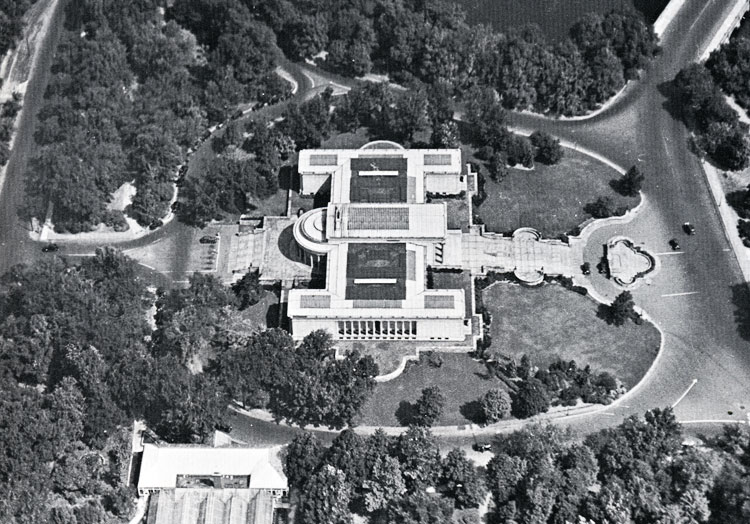
1942 aerial view of the Albright Art Gallery, which sits in the middle of a circular traffic pattern. The park's Delaware Greenhouse is
visible at bottom left. Image source: "100: The Buffalo Fine Arts Academy"
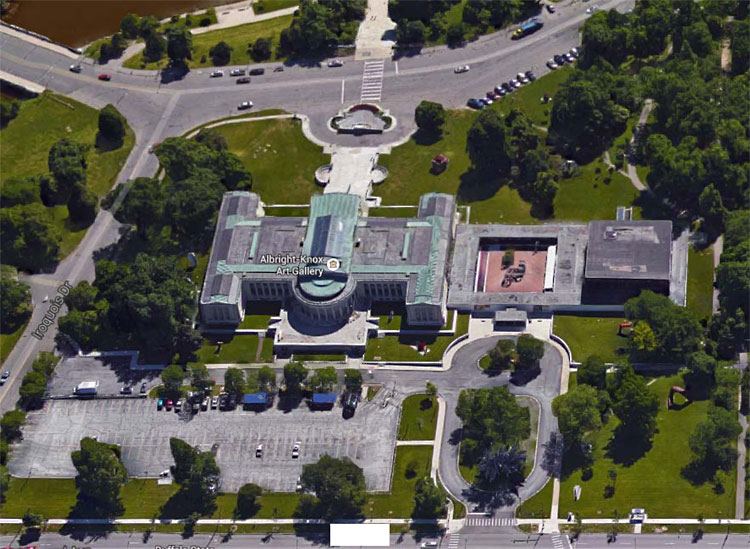
Google Earth View of the Albright-Knox Art Gallery.
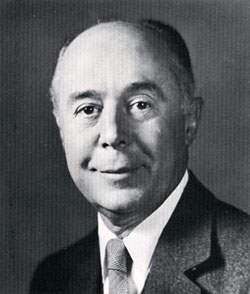 Seymour H. Knox. Image source: "100"
Seymour H. Knox. Image source: "100"
The John W. Cowper Co. was engaged for construction. No public funds appeared and, on June 10, 1960, the Seymour Knox Foundation donated $1,400,000 towards the planned $1,700,000 construction costs. Private donations covered the remainder. Ground was broken the next month.
Without any public coverage, the parking location was changed from the new addition to the front of the Elmwood entrance. On May, 17, 1961, the stairs were removed from the Elmwood side and a retaining wall erected; the grand entrance from Elmwood was erased by the new parking lot. E.B.Green's plan, whose balanced design was not to have been altered, was changed forever.
On August, 7, 1961, the Board of the Buffalo Fine Arts Academy, announced that the gallery would henceforth be known as the Albright-Knox Art Gallery in honor of its largest modern benefactor of funds and artwork.
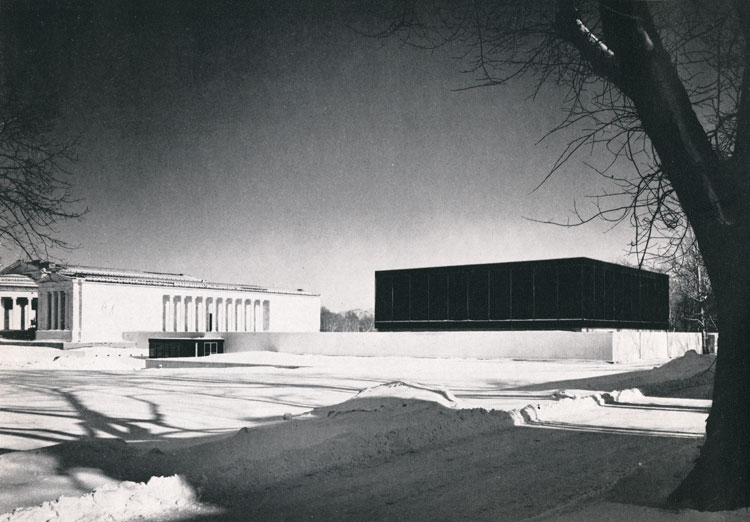
View of the new addition, 1962. Image source: Architectural Forum
The Bunshaft design for the addiiton, however, was largely praised as respecting the 1905 gallery. Bunshaft himself said, "Seymour Knox treated me like I was Michaelangelo, and I worked harder on that building that I have ever worked in my life." Architectural Forum featured the project in its March, 1962 issue and said of the design, "The result is a striking harmony between old and new, without any obtrusion upon the handsome, Ionic-columned facades." Bunshaft received the American Institute of Architect's annual award for this International Style design. Even those who were less than enthusiastic about the addition praised the glass-walled auditorium for the way visitors felt part of the outdoors while sitting in its red seats.
"The Art Gallery" magazine wrote that the gallery "is a fascinating building housing traditional and modern art side by side in a modern atmosphere." Its contemporary collection was described as "a who's who of modern art."
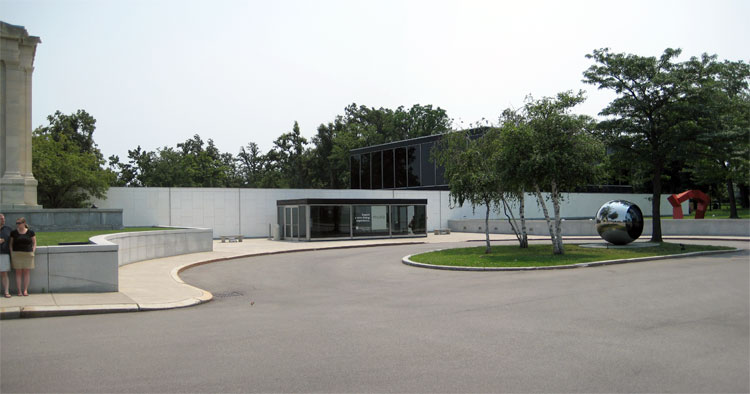
The main entrance to the Albright-Knox.
In 2015, the Albright-Knox Art Gallery prepared for a second expansion, first hinted in 2001. Public meetings were held and member input sought. Nearly everyone agreed than an expansion on its current location would be preferred, but there was also emphasis on the 1905 building in member comments. There was some preference for restoring the entrance to the Central Court. Other ideas included connecting the gallery to the Burchfield Penney Art Gallery uninterrupted by traffic, and avoiding any additional incursion on parkland. Director Janne Siren summarized current thinking thus: "The city is different today than it was in the 50's and 60's...In some respects, the ideas of public space that we seek today are more analogous to the civic spaces that were built circa 1900 than they were in the 1950's."

Among the preferred changes was a request to remove the city's surface parking lot; the most provocative, and expensive, would be to place parking underground.
In 2020, after much spirited discussion, a major addition to the Albright_Knox has begun construction. When completed, the institution will be renamed "The Buffalo Albright-Knox-Gundlach Art Museum" in honor of donor Jeffrey Gundlach's major donation to the project. Below is a concept drawing of the addition and reconfiguring that will be complete by 2022.
